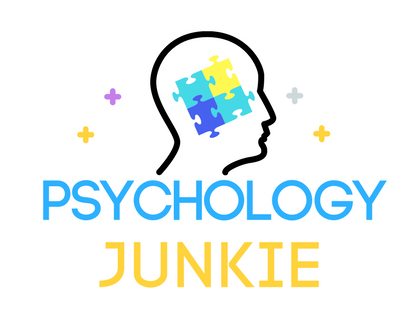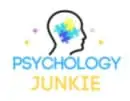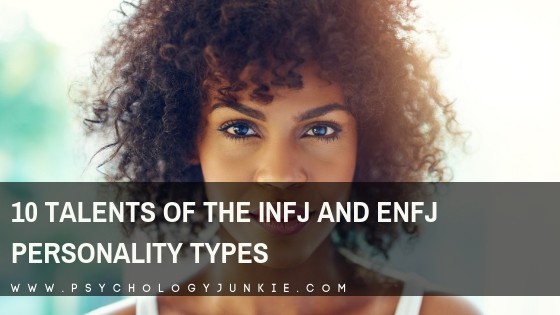Signs That You’re One-Sided, Based On Your Myers-Briggs® Personality Type
Ever wondered why certain personality types just irk you to no end? A lot of times when someone annoys us, they’re either one-sided or we are. Many people don’t realize they’re being one sided; they simply believe they’re being “normal.” When we don’t know about personality type, we often go on “auto-pilot” with our personality type; repeating behaviors and patterns that may be doing us harm in the long run. That’s why today’s article is so important and I really hope you’ll enjoy it.
Not sure what your personality type is? Take our personality questionnaire here. Or you can take the official MBTI® here.

Table of contents
- The One-Sided Versions of Every Myers-Briggs® Personality Type
- ISFJs:
- ISTJs:
- ESFP:
- ESTP:
- INFJs:
- INTJs:
- ENFPs:
- ENTPs:
- ESFJs:
- ESTJs:
- ISFPs:
- ISTPs:
- ENFJs:
- ENTJs:
- INFPs:
- INTPs:
- How to Get Out of One-Sidedness (for all the types):
- These Articles Can Help You Find More Ways to Achieve Balance:
- What Are Your Thoughts?
- References:
Estimated reading time: 23 minutes
The One-Sided Versions of Every Myers-Briggs® Personality Type
ISFJs:
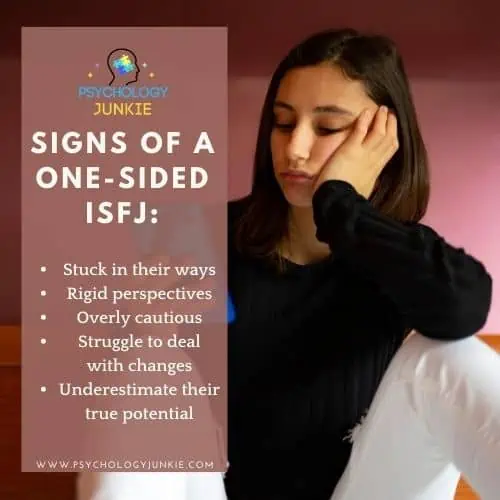
ISFJs are known for being conscientious, loyal, and responsible. However, when they are immature, they become stuck in the past and suspicious of anything new or outside their traditions. They may rigidly follow the same routine every single day, or associate only with people who have similar traditions or lifestyles. Staying with like-minded people isn’t bad, in and of itself, but often this results in judgmental or narrow-minded behavior towards people who are different from the ISFJ’s circle.
Many people hear this and imagine that one-sided ISFJs are socially conservative people who don’t like anything progressive. This is hardly the case. One-sided ISFJs can look like socially conservative people who hate progressiveness, but they can also look like someone on the opposite end of the spectrum. They may be socially progressive to an extreme, casting suspicion and harsh judgment on anyone outside of that way of thinking. Every ISFJ is different, but one-sided ISFJs will stick to what they know through experience and feel skeptical and judgy about things outside of that experience.
One-sided ISFJs can also struggle to see their own potential. Because they trust the past to inform the present, they can struggle to see a future beyond the present moment or they may have paranoid ideas about the future. They may also exhibit pat-rack behavior, where they obsess over small details and believe that each object has sentimental value and thus cannot be discarded.
Find out more about ISFJs: The ISFJ Personality Type and the Enneagram
ISTJs:
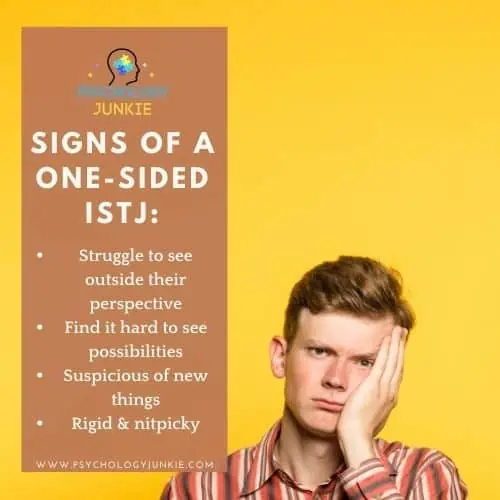
ISTJs are often seen as dependable, organized, and detail-oriented. However, when they are one-sided, they can feel overwhelmed by responsibilities and tasks that don’t ultimately provide fulfillment. They can also be very nit-picky about how things are done, to the point where they can’t delegate or get help and feel they must do everything themselves.
One-sided ISTJs can also be too rigid with their plans. They may struggle to be spontaneous and have difficulty adapting to unforeseen changes, often resulting in frustration or anger. They may also take on too much responsibility for others, which can lead to burnout or resentment directed towards those around them.
Like ISFJs, ISTJs can also get stuck in the mindset that their traditions and experiences are the only real and trustworthy ones. They may be harsh and judgmental to people who challenge their views or traditions and fight against them without fully taking the time to understand their experiences and perspectives. They may be resistant change or try to create rules and guidelines that force others to comply with their narrow perspectives. Again, as with ISFJs, this can look extremely different depending on the experiences and traditions and worldviews of the ISTJ in question.
Find out more about ISTJs: 12 Amazing Fictional ISTJ Characters
ESFP:
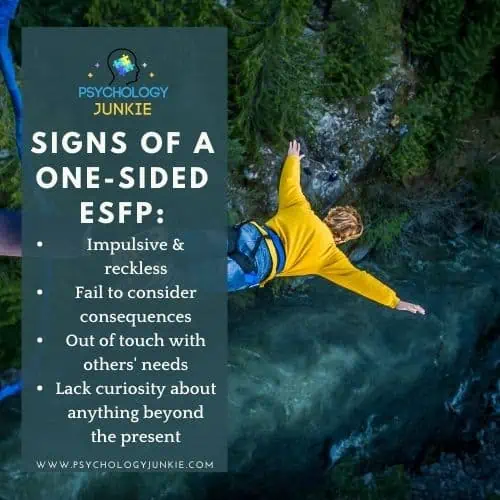
ESFPs are outgoing, adventurous, and aware of opportunities for fun and excitement. However, when they are one-sided they can become hedonistic and impulsive; seeking out pleasure and fun at the cost of their own health, well-being, or long-term satisfaction. They also become easily bored, and jump from one thing to another in search of the next thrill.
One-sided ESFPs can struggle with commitment because they fear missing out on something better, or have difficulty following through on tasks that don’t provide immediate gratification. Conversations about abstract subjects can be overwhelming or boring to them, as they only value topics that involve tangible reality or opportunities in the present. They also tend to hate any kind of long-term planning, feeling that it is a waste of time because the future is never certain. Thus they may live from moment to moment, never really coming up with a clear path for their life.
This live-in-the-moment mindset can be good at times. But one-sided ESFPs tend to struggle to create a sense of stability in their lives. They have difficulty following through on important tasks and commitments and end up feeling like their life is chaotic and out of control. This can lead to an overall feeling of dissatisfaction as the ESFP cannot make progress towards any kind of goal or dream.
ESTP:
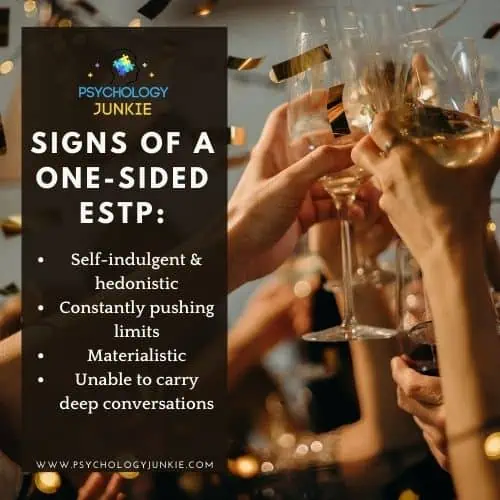
ESTPs are known for being curious, energetic, and clever. However, when they’re one-sided, they become more materialistic and reckless. Rather than thinking rationally about long-term consequences, they become interested in immediate pleasure and seek fun over long-term meaning and purpose. They may struggle to maintain deeper emotional connections and can check out when people are talking too deeply about anything without an immediate application.
One-sided ESTPs can become overly competitive and aggressive in their pursuits. They are focused only on the short-term rewards, and feel it’s pointless to consider the future because that is so unpredictable and difficult to control. They may also be reckless in their decisions, taking risks without considering consequences. This can result in impulsivity, a lack of financial stability, or other issues that can have a negative effect on their lives.
Furthermore, one-sided ESTPs may struggle to make strong and meaningful relationships. They may be too focused on materialistic pleasures or short-term rewards to invest fully in a relationship, leading them to move quickly from person to person without ever developing any kind of strong bond. This can lead to a feeling of loneliness and isolation that can be difficult to escape.
INFJs:
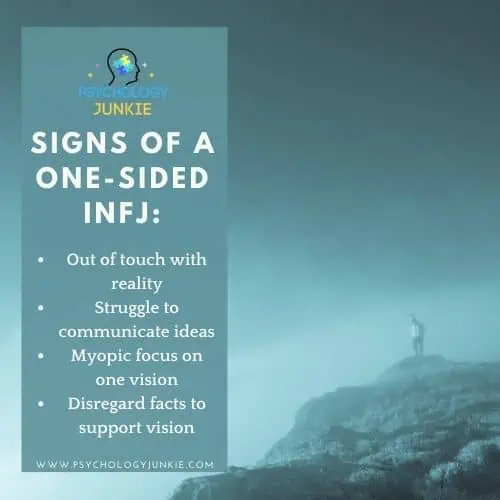
INFJs are focused on personal growth, relationships, and understanding the world around them. When immature, an INFJ can become overly focused on ideas and lose sight of tangible realities like physical health, their budget, or practical daily needs. The world around them fades away and they can get wrapped up in ideas, imaginations, and visions that pull them away from what’s real and direct them towards fruitless fantasizing.
One-sided INFJs may struggle to express themselves, preferring instead to retreat into deep thoughts and emotions. This can lead to issues with communication and social interactions, as they may feel overwhelmed by what to say or how to participate. They may also struggle to form meaningful connections, as they get too lost in their own thoughts and ideas to really engage with others on a deeper level. Instead, they may view others as “less than” themselves because they can’t speak in a way that others naturally understand. At other times, they may disparage themselves for not fitting in with others.
In addition, one-sided INFJs can become overly-attached to their own vision or worldview. They may refuse to listen to or accept other perspectives that don’t align with what they already believe, becoming myopic and narrow-minded. This can lead to being overly critical of those who don’t conform to their beliefs, or pushing away potentially meaningful relationships because of a lack of openness and flexibility.
Find out more about INFJs: How INFJs Say “I Love You”
INTJs:
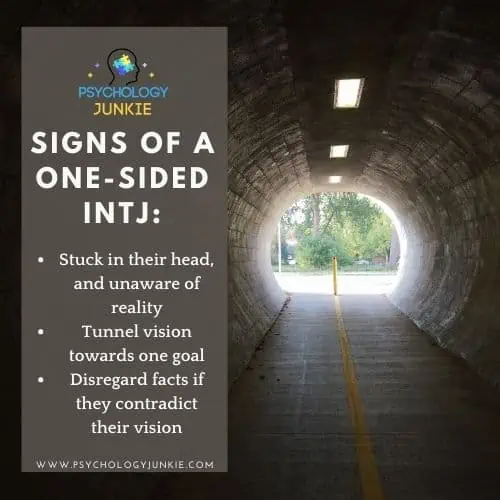
INTJs are deep thinkers who use their intellect to achieve far-reaching goals. When they have a vision in mind, they tend to put everything behind that vision. This can lead to neglect of anything outside that goal, including health, relationships, or personal upkeep. One-sided INTJs often see any interruption from their main vision as a hassle that needs to be silenced. Thus, they blow up over interruptions and distractions; harming relationships and appearing much colder than they’d be at a healthy level.
One-sided INTJs can also become so fixated on their intuitive vision that they ignore practicalities and details that could contradict their ideas or plans. Thus they may put all of their energy into achieving something and have it fail because they dismissed a bunch of details that piled up into something really devastating.
In addition, they may become so stubborn in their vision that they reject other ideas or perspectives altogether, disregarding any valuable input from those around them. This can lead to a lack of strong relationships as people feel unable to communicate with or understand the INTJ’s single-mindedness. They may also struggle to collaborate effectively as it is hard for them to accept ideas that they do not come up with themselves.
Discover more about INTJs: The 10 Best Careers for INTJs
ENFPs:
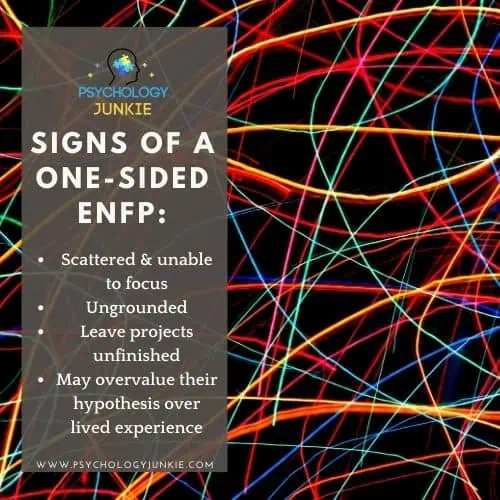
ENFPs are creative and free-spirited, often looking for new experiences that they can throw themselves into whole-heartedly. When one-sided, ENFPs are hungry for opportunity, but take on too many projects at once. Their actions are arbitrary rather than strategic, often leading to a lack of tangible results. They may also struggle with commitment; if something becomes too hard or boring, they may quickly jump ship and move onto the next thing without finishing what they started.
One-sided ENFPs can become overly idealistic and fixated on perfect solutions that may never exist. This can lead to an inability to make decisions or take action, as they are unable to settle for anything less than perfect. They may also struggle to have meaningful relationships, as others tend to feel that their idealism is unrealistic and too hard to live up to.
Furthermore, one-sided ENFPs can get stuck “re-inventing the wheel.” Because they like to do everything in new ways, they may devote a lot of time and energy to restructuring something or brainstorming novel solutions when a perfectly good traditional method is already available.
Discover more about ENFPs: How to Communicate Effectively with an ENFP
ENTPs:
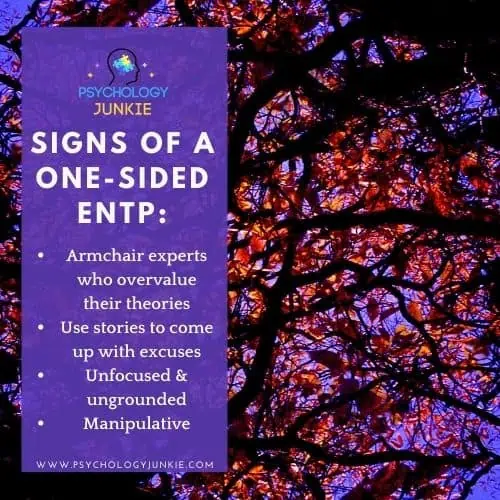
ENTPs are curious and inquisitive by nature, always looking for the next big thing. When immature, an ENTP may become overly focused on possibilities, but to no productive end. They wind up wasting their energy with ideas that lack true potential. At the same time, they may lose sight of their own guiding compass: their thinking and feeling sides that help them make decisions in line with logic and values. Because they’re one sided, they race after possibilities but ignore little warnings and insights from their mind and heart.
One-sided ENTPs can also find it hard to remain focused on one thing for too long. They get distracted easily and have difficulty finishing tasks, often leading to a lack of tangible results in their lives. Relationships can feel like a minefield as well, as others feel that the ENTP is always stuck in the future and never really present in the current moment. They may be seen as flighty or unreliable, unable to stay committed to anything for too long.
Another struggle of one-sided ENTPs is that they may not know how to be serious when it’s needed. ENTPs are known for their sense of humor and fun; but at a one-sided level, they can struggle to hold down any kind of heavy conversation. Anytime things get uncomfortable, they use humor to make light of things, avoid self-examination, or even manipulate a situation to their own advantage. This can lead to misunderstandings and feelings of alienation between the ENTP and those they interact with.
Discover more about ENTPs: Your ENTP Personality and Your Enneagram Type
ESFJs:
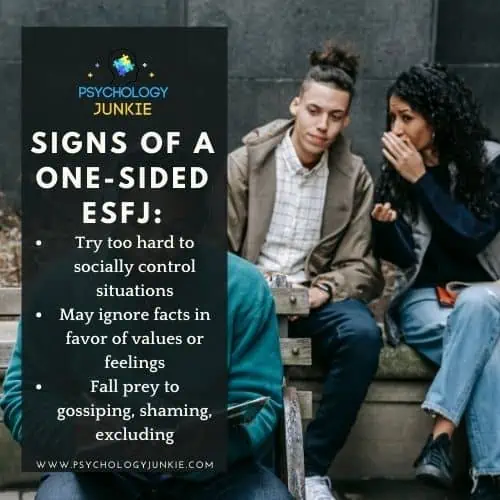
ESFJs are known for their caring and supportive natures, and they often place the needs of others before their own. However, one-sided ESFJs can show up in varied ways that are both detrimental to themselves and others.
One type of one-sided ESFJ fixates so much on other people’s feelings and needs that they become invisible to themselves, to the point of co-dependency and self-neglect. These ESFJs are overwhelmed, exhausted, and pulled in dozens of directions to try to satisfy everyone else’s “needs” or wants. These ESFJs may be plagued by feelings of resentment and harbor bitterness towards the very people they are trying to help. While they may appear warm and engaging on the outside, they often feel depleted and empty on the inside.
Another type of one-sided ESFJ believes in social control and may harness social weapons like gossip, shaming, and exclusion in order to maintain a sense of social power and control in relationships. These ESFJs are often masters at shutting down any criticism, recalling all the times they were there for people who needed them and seeing themselves as indispensable and undeserving of criticism.
ESTJs:

ESTJs are known for their logical and organized approach to life, often taking on leadership roles due to their ability to plan and manage resources. However, one-sided ESTJs can be so consumed by tasks, work, and projects that they exhaust themselves in the process. They feel “trapped by the clock” and often struggle in their personal relationships. Any interruption to “the plan” can feel like an insult to their very being.
These ESTJs can bring an inflexible and dogmatic attitude to relationships, insisting that things be done in a certain way and rejecting any alternative approaches or ideas. This leads to feelings of frustration for those around them, particularly if the ESTJ is unwilling to compromise on anything.
One-sided ESTJs may also struggle to express and share their feelings openly. They often feel uncomfortable in emotional situations and can come off as cold and uncaring as a result. It’s not that they don’t care about others, they just dismiss feelings and emotions as unimportant. In turn, they may be very wealthy or “successful” in certain ways, but deeply unhappy and empty on the inside. When they need help of an emotional kind, they may not know where to turn.
ISFPs:
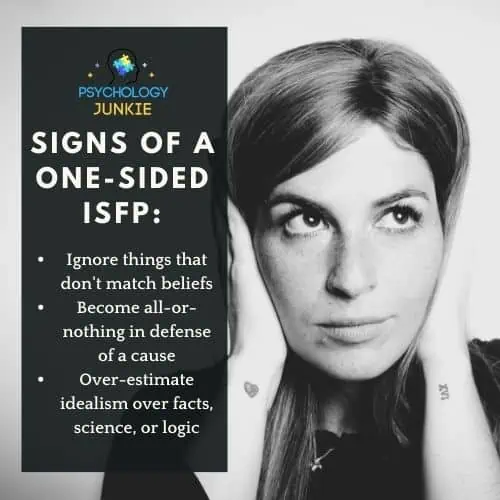
ISFPs are often known for their gentle and creative spirits, bringing a unique energy to any situation they encounter. They tend to be open-minded and accepting of others, while also being introspective and in touch with their own feelings. That said, one-sided ISFPs will not look as accepting and gentle as healthy ISFPs. They are so driven by an inner sense of right and wrong that they may demonize those who do not share their beliefs. Rather than checking facts, hearing another perspective, or giving others the “benefit of the doubt”, one-sided ISFPs approach the world with a sense of moral absolutism. However, it may not look like moral absolutism because the morals they choose to adopt are uniquely their own and are often non-traditional.
These ISFPs may also struggle to trust and connect with others, as they are often so focused on their own inner world that it can become hard to relate to external realities. Consequently, one-sided ISFPs may feel disconnected from the people around them and unable to form meaningful relationships. This can lead to feelings of isolation and can cause the ISFP to double-down on their stance that they are a lone outsider in a world filled with corruption.
Furthermore, these ISFPs may find it difficult to stay motivated and productive due to their tendency to get stuck in their feelings of the moment. One small setback can derail them entirely from a task or project, and they can become so absorbed in their own inner world that they forget to finish things. This can lead to difficulty holding down a job, budgeting, or achieving meaningful goals.
Find out more about ISFPs: Here’s Why It’s So Hard for ISFPs, INFPs, ESFPs, and ENFPs to Let Go of Bad Things
ISTPs:
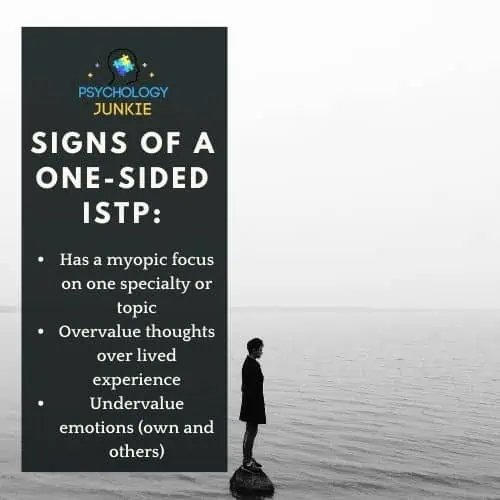
ISTPs are known for their independent and analytical natures, often approaching life with a detached curiosity. Logical and pragmatic, they put their ingenious thoughts to the test through real-world action and experimentation. That said, one-sided ISTPs can be so caught up in specializing in one area of knowledge that they neglect other areas of their life.
These ISTPs find it difficult to engage in anything outside of their area of specialization. Casual conversation feels totally draining, and they may write off friendships or relationships because no one can keep up with their intense focus on one area of interest. On top of that, they tend to emphasize negatives over positives and see only things to be critiqued or debated rather than things to praise. This can lead to frustration and misunderstanding in their relationships, as well as a sense of restlessness that leaves them feeling like they are “missing something.”
Finally, these ISTPs may struggle with decision-making. They want to find the “optimal” solution, which often leads to analysis paralysis or an inability to make any decisions at all due to their need for perfection. Consequently, they may find themselves stuck in a state of limbo, unable to move forward or make progress on anything.
ENFJs:
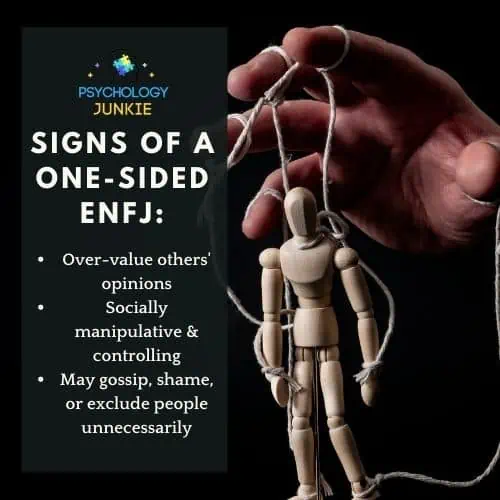
ENFJs are often known for their compassionate and intuitive natures. As idealists, they long to make the world a better place by catalyzing people towards their potential.
However, one-sided ENFJs can become so driven by helping others that they forget how to take care of themselves. These ENFJs tend to be too hard on themselves, constantly seeking to meet impossible standards and never feeling like they’ve done enough. They are visionary by nature, but may be so invested in their vision that they lose track of their health or practical needs.
Other one-sided ENFJs may rely on social control or manipulation as a way of getting people to do what they want. These ENFJs may appear friendly at first glance, but underneath they can be manipulative and controlling. They may also build up a web of lies and half-truths in order to maintain their image or sway people in the direction they believe is “best” for them.
Finally, one-sided ENFJs tend to struggle with feedback. It doesn’t matter how gentle it is – any criticism or feedback can feel like an attack on their character. This leads to feelings of hurt and insecurity, which can be further exacerbated by their tendency to internalize criticism as personal failure. These ENFJs may become paralyzed by critique and feel unable to find a way forward; repeatedly criticizing themselves and feeling like they’ll never be “correct enough” to succeed in their goals.
ENTJs:

ENTJs are often seen as natural-born leaders, with a hunger for knowledge and mastery that drives them. These rational types strive for continual progress and have a visionary quality that draws others in. That said, one-sided ENTJs may have such a focus on their goals that they forget about the people working alongside them.
These ENTJs are so focused on getting the job done that they disregard the feelings of the people they are working with or even step on their toes in order to reach the next rung on their road for success. People become pawns for the one-sided ENTJ; and they may struggle to understand why anyone would even see this as problematic. Often they believe their goals are what’s best for everyone in the long run so they don’t understand why people wouldn’t want to comply.
Further, these ENTJs may push themselves so hard that they lose sight of their health, their relationships, and their own well-being. They may be so fixated on productivity and success that they forget to rest or relax, leading to burnout and exhaustion. Additionally, one-sided ENTJs may feel like nothing is ever good enough —they will endlessly criticize themselves and others for not being perfect or living up to their high standards.
INFPs:
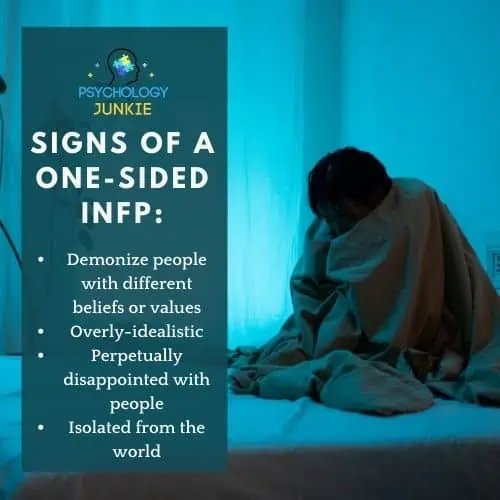
INFPs are known for their peaceful and imaginative natures. Compassionate and gentle, they are deeply attuned to the emotional world and strive to make a positive difference in the world. That said, one-sided INFPs may be so caught up in their imagination and their inner feelings that they struggle to translate their ideas into reality.
These INFPs may have grand ideas but lack the focus and organization necessary to bring them to fruition. As a result, they can become frustrated and overwhelmed when things don’t work out the way they had envisioned it. They may also become so absorbed in their own feelings that any criticism or pushback from others can be extremely hurtful and discouraging.
Idealism is a strength of INFPs, but it can be taken too far with one-sided INFPs. For these INFPs, reality can feel like a crushing disappointment. They romanticize the world and set up standards for themselves and others that no one can realistically live up to. These INFPs may fall prey to “us vs them” dynamics, believing that their cause is the one true cause and vilifying anyone who disagrees with their perspectives. This can lead to them cutting people out of their lives without taking time to check facts, actively listen, or analyze their own beliefs critically.
Find out more about INFPs: Are INFPs Empaths?
INTPs:
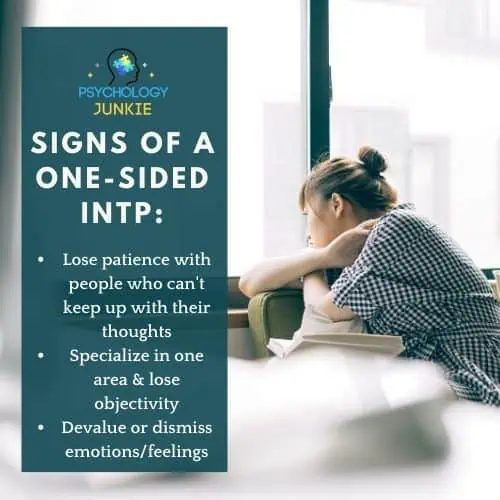
INTPs are known for their innovative and analytical minds. They love to think deeply and figure out how things work, which makes them excellent problem-solvers. However, one-sided INTPs can become so caught up in their ideas that they forget about the practicalities of life.
These INTPs may get lost in their theoretical musings and fail to take action in the real world. They can become so obsessed with understanding how an idea works in theory that they lose sight of real world practice or practical application. They may also become so caught up in their own minds that they forget to interact with other people or even take care of themselves.
One-sided INTPs may also have difficulty forming connections with others. These INTPs have a myopic focus on their area of specialization and can struggle to make room for anything else.They have a tendency to tune out of conversations that don’t revolve around their interests and can struggle to adequately value the feelings of others. Consequently, they may find it difficult to form meaningful connections with others, which can lead to loneliness or feeling misunderstood. In the end, they may believe that others aren’t “smart enough” to keep up with them or that they are socially doomed and incapable of having happy relationships.
Find out more about INTPs: Why INTPs Feel Overwhelmed When Looking for Friends
How to Get Out of One-Sidedness (for all the types):
The key to getting out of one-sidedness is developing self-awareness and striving for balance. It’s important to recognize that being one sided can be detrimental to your health, relationships, and overall well-being —and it’s not something you need to suffer through.
For Thinking types, this can look like making some time to bring in new information, including emotional information. Experience new things, talk to new people, assess your values, and figure out what ultimately gives you a sense of meaning.
For Feeling types, it can look like actively engaging in both the emotional and logical sides of an argument or situation. You don’t have to disregard your feelings —just make sure that you take time to think through things from a logical perspective as well. Assess opposing viewpoints to understand the logic of where other people are coming from.
For Intuitive types, this can look like making room for the real world. When you find yourself lost in ideas and feeling ungrounded, take a break and ground yourself in reality. Take a walk in nature, check whether you are thirsty or hungry, or practice mindfulness.
For Sensing types, this can look like exploring the possibilities of life. Get curious about what’s out there, and take some time to fantasize or brainstorm new ideas. Ask yourself the big questions, like what do you want out of life when you reach the end? What does happiness really mean to you? What are the patterns you are creating in your own life and where will they lead?
Start by taking the time to identify which areas in life you may be neglecting; friendships, hobbies, physical health etc. Then, take steps to rectify this by making more time for the things that challenge you while also bringing you joy and fulfillment.
Additionally, it’s important to recognize when a situation is out of your control and practice letting go of stubbornness or perfectionism. Sometimes we veer into one-sidedness because we are so fixated on one right way to do things or one perfect vision or goal we have to achieve.
Lastly, pay attention to how you relate to others —what are your expectations? Are you being too harsh on yourself or everyone around you? Are you isolating yourself from people unnecessarily? Are you so busy taking care of people that you’re disappearing to yourself? Make sure you’re balancing alone time with time for meaningful relationships.
These Articles Can Help You Find More Ways to Achieve Balance:
Secrets to Happiness for Every Myers-Briggs® Personality Type
How to Improve Your Weaknesses, Based On Your Myers-Briggs® Personality Type
The Emotionally Intelligent Versions of Every Myers-Briggs® Personality Type
What Are Your Thoughts?
Did you enjoy this article? Do you have any tips or advice for other people with your personality type? Let us know in the comments please!

References:
The Magic Diamond: Jung’s 8 Paths for Self-Coaching by Dario Nardi (Radiance House, 2020)
Personality Hacker: Harness the power of your personality type to transform your work, relationships and life by Joel Mark Witt and Antonia Dodge (Ulysses Press, 2018)
Understanding Yourself and Others™ An Introduction to the Personality Type Code by Linda V. Berens and Dario Nardi (InterStrength, 2004)
